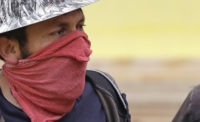In the transformation of journalism by electronic media, fast often wins out over comprehensive and measured. Being aware of this temptation, however, didn’t protect me from falling into the trap. Three weeks ago, I cobbled together a story that had already appeared in some other news media about a team of Duke University PhDs who had completed and published a study about a new method for testing masks for aerosol virus droplet spread. In the test, subjects spoke a few words into a darkened chamber through different styles of face masks. The droplet spread was illuminated by a laser and video recorded with a mobile phone.
Jobsite safety has been an obsession since the beginning of the pandemic, as have protective face coverings. Recall that many construction projects, deemed essential, were licensed to churn onward as other businesses shut down. Employers adopted new safety protocols, but outbreaks still emerged at projects. Construction workers everywhere seemed to have to choose between pay and health.
For the Duke study, which appeared online in the journal Science Advances, the research team subjected a variety of face coverings to the new test. What stood out were the results for what are called fleeces, buffs or gaiters. They seemed to worsen the spread of the smallest, longest-floating micro-droplets, and in a paragraph or so the authors speculated that an apparent filtering effect was the cause.
I joined other reporters in emphasizing the gaiter result, first headlining the ENR.com story as “Study Says Popular Face Covering Could Worsen Virus Spread.” The story lacked some needed context and qualifications and rushed past the essence of the research, which was producing a new face-covering test tool, not authoritative evaluations of face coverings. At the time of posting the authors had not yet replied to my inquiries.
And almost at once upon posting the story I thought I may have overplayed the potential of any gaiter to worsen virus spread. We heard doubts from a knowledgeable industry safety manager and a prominent safety equipment and gaiter maker. The New York Times science staff, several days later, posted a critical story about the study and its news coverage, headlined “Save the Gaiters!” In it, one expert stated that filtration through fabric into smaller droplets was “not the way filtration works.” Another source stated that any face covering helps.
Although the gaiters are valuable and especially helpful by allowing wearers to stay cool, we don’t agree that differences among face coverings are irrelevant. But after hearing the qualifications from the Duke study authors, ENR posted a longer, more proportional treatment of the subject, noting that the Duke report used the thinnest type of gaiter fabric. We also noted that the mask differences the Duke study showed deserve more study. That story appears in ENR 8/24 p. 8 and has more of the needed context that is a critical part of ENR’s mission.






Post a comment to this article
Report Abusive Comment